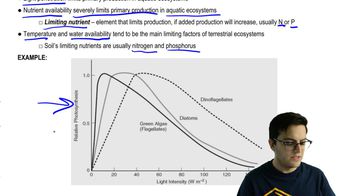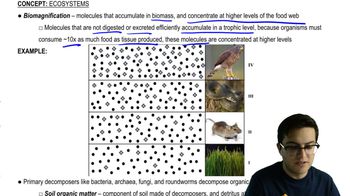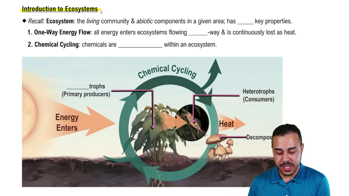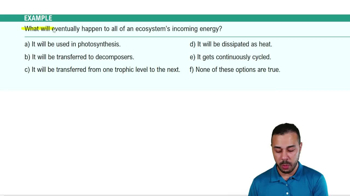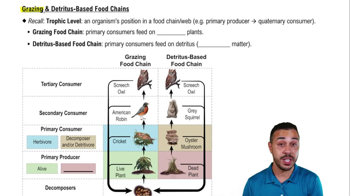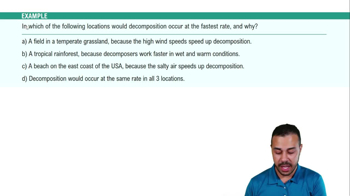Table of contents
- 1. Introduction to Biology2h 42m
- 2. Chemistry3h 40m
- 3. Water1h 26m
- 4. Biomolecules2h 23m
- 5. Cell Components2h 26m
- 6. The Membrane2h 31m
- 7. Energy and Metabolism2h 0m
- 8. Respiration2h 40m
- 9. Photosynthesis2h 49m
- 10. Cell Signaling59m
- 11. Cell Division2h 47m
- 12. Meiosis2h 0m
- 13. Mendelian Genetics4h 44m
- Introduction to Mendel's Experiments7m
- Genotype vs. Phenotype17m
- Punnett Squares13m
- Mendel's Experiments26m
- Mendel's Laws18m
- Monohybrid Crosses19m
- Test Crosses14m
- Dihybrid Crosses20m
- Punnett Square Probability26m
- Incomplete Dominance vs. Codominance20m
- Epistasis7m
- Non-Mendelian Genetics12m
- Pedigrees6m
- Autosomal Inheritance21m
- Sex-Linked Inheritance43m
- X-Inactivation9m
- 14. DNA Synthesis2h 27m
- 15. Gene Expression3h 20m
- 16. Regulation of Expression3h 31m
- Introduction to Regulation of Gene Expression13m
- Prokaryotic Gene Regulation via Operons27m
- The Lac Operon21m
- Glucose's Impact on Lac Operon25m
- The Trp Operon20m
- Review of the Lac Operon & Trp Operon11m
- Introduction to Eukaryotic Gene Regulation9m
- Eukaryotic Chromatin Modifications16m
- Eukaryotic Transcriptional Control22m
- Eukaryotic Post-Transcriptional Regulation28m
- Eukaryotic Post-Translational Regulation13m
- 17. Viruses37m
- 18. Biotechnology2h 58m
- 19. Genomics17m
- 20. Development1h 5m
- 21. Evolution3h 1m
- 22. Evolution of Populations3h 52m
- 23. Speciation1h 37m
- 24. History of Life on Earth2h 6m
- 25. Phylogeny2h 31m
- 26. Prokaryotes4h 59m
- 27. Protists1h 12m
- 28. Plants1h 22m
- 29. Fungi36m
- 30. Overview of Animals34m
- 31. Invertebrates1h 2m
- 32. Vertebrates50m
- 33. Plant Anatomy1h 3m
- 34. Vascular Plant Transport1h 2m
- 35. Soil37m
- 36. Plant Reproduction47m
- 37. Plant Sensation and Response1h 9m
- 38. Animal Form and Function1h 19m
- 39. Digestive System1h 10m
- 40. Circulatory System1h 57m
- 41. Immune System1h 12m
- 42. Osmoregulation and Excretion50m
- 43. Endocrine System1h 4m
- 44. Animal Reproduction1h 2m
- 45. Nervous System1h 55m
- 46. Sensory Systems46m
- 47. Muscle Systems23m
- 48. Ecology3h 11m
- Introduction to Ecology20m
- Biogeography14m
- Earth's Climate Patterns50m
- Introduction to Terrestrial Biomes10m
- Terrestrial Biomes: Near Equator13m
- Terrestrial Biomes: Temperate Regions10m
- Terrestrial Biomes: Northern Regions15m
- Introduction to Aquatic Biomes27m
- Freshwater Aquatic Biomes14m
- Marine Aquatic Biomes13m
- 49. Animal Behavior28m
- 50. Population Ecology3h 41m
- Introduction to Population Ecology28m
- Population Sampling Methods23m
- Life History12m
- Population Demography17m
- Factors Limiting Population Growth14m
- Introduction to Population Growth Models22m
- Linear Population Growth6m
- Exponential Population Growth29m
- Logistic Population Growth32m
- r/K Selection10m
- The Human Population22m
- 51. Community Ecology2h 46m
- Introduction to Community Ecology2m
- Introduction to Community Interactions9m
- Community Interactions: Competition (-/-)38m
- Community Interactions: Exploitation (+/-)23m
- Community Interactions: Mutualism (+/+) & Commensalism (+/0)9m
- Community Structure35m
- Community Dynamics26m
- Geographic Impact on Communities21m
- 52. Ecosystems2h 36m
- 53. Conservation Biology24m
52. Ecosystems
Introduction to Ecosystems
Problem 5`
Textbook Question
Which of the following has the greatest effect on the rate of chemical cycling in an ecosystem?
a. The rate of decomposition in the ecosystem
b. The production efficiency of the ecosystem's consumers
c. The trophic efficiency of the ecosystem
d. The location of the nutrient reservoirs in the ecosystem
 Verified step by step guidance
Verified step by step guidance1
Understand that chemical cycling in an ecosystem refers to the movement and exchange of organic and inorganic matter back into the production of living matter.
Recognize that decomposition is a critical process in chemical cycling, as it breaks down dead organic material, returning nutrients to the soil and making them available for producers.
Consider the role of decomposers, such as bacteria and fungi, which are responsible for breaking down complex organic materials into simpler substances.
Evaluate how the rate of decomposition directly affects the speed at which nutrients are recycled and made available to primary producers, thus influencing the overall rate of chemical cycling.
Conclude that among the given options, the rate of decomposition in the ecosystem (option a) has the greatest effect on the rate of chemical cycling, as it directly impacts the availability of nutrients for other organisms.
 Verified video answer for a similar problem:
Verified video answer for a similar problem:This video solution was recommended by our tutors as helpful for the problem above
Video duration:
2mPlay a video:
Was this helpful?
Key Concepts
Here are the essential concepts you must grasp in order to answer the question correctly.
Rate of Decomposition
The rate of decomposition refers to how quickly organic matter is broken down into simpler substances by decomposers like bacteria and fungi. This process is crucial for recycling nutrients back into the ecosystem, influencing the availability of essential elements for plant growth and overall ecosystem productivity.
Recommended video:
Guided course

Metabolic Rate
Production Efficiency
Production efficiency is the measure of how effectively consumers in an ecosystem convert the energy they ingest into biomass. It affects the energy flow and nutrient cycling within the ecosystem, as higher efficiency means more energy is retained within the consumer level, potentially impacting the rate of chemical cycling.
Recommended video:
Guided course

Making Sense of Ecosystem Production & Efficiency
Trophic Efficiency
Trophic efficiency describes the percentage of energy transferred from one trophic level to the next in an ecosystem. It is a key factor in determining the energy flow and nutrient cycling, as lower efficiency results in less energy being passed up the food chain, affecting the overall dynamics and chemical cycling rates.
Recommended video:
Guided course

Secondary Production and Trophic Efficiency

 4:07m
4:07mWatch next
Master Introduction to Ecosystems with a bite sized video explanation from Jason
Start learningRelated Videos
Related Practice





